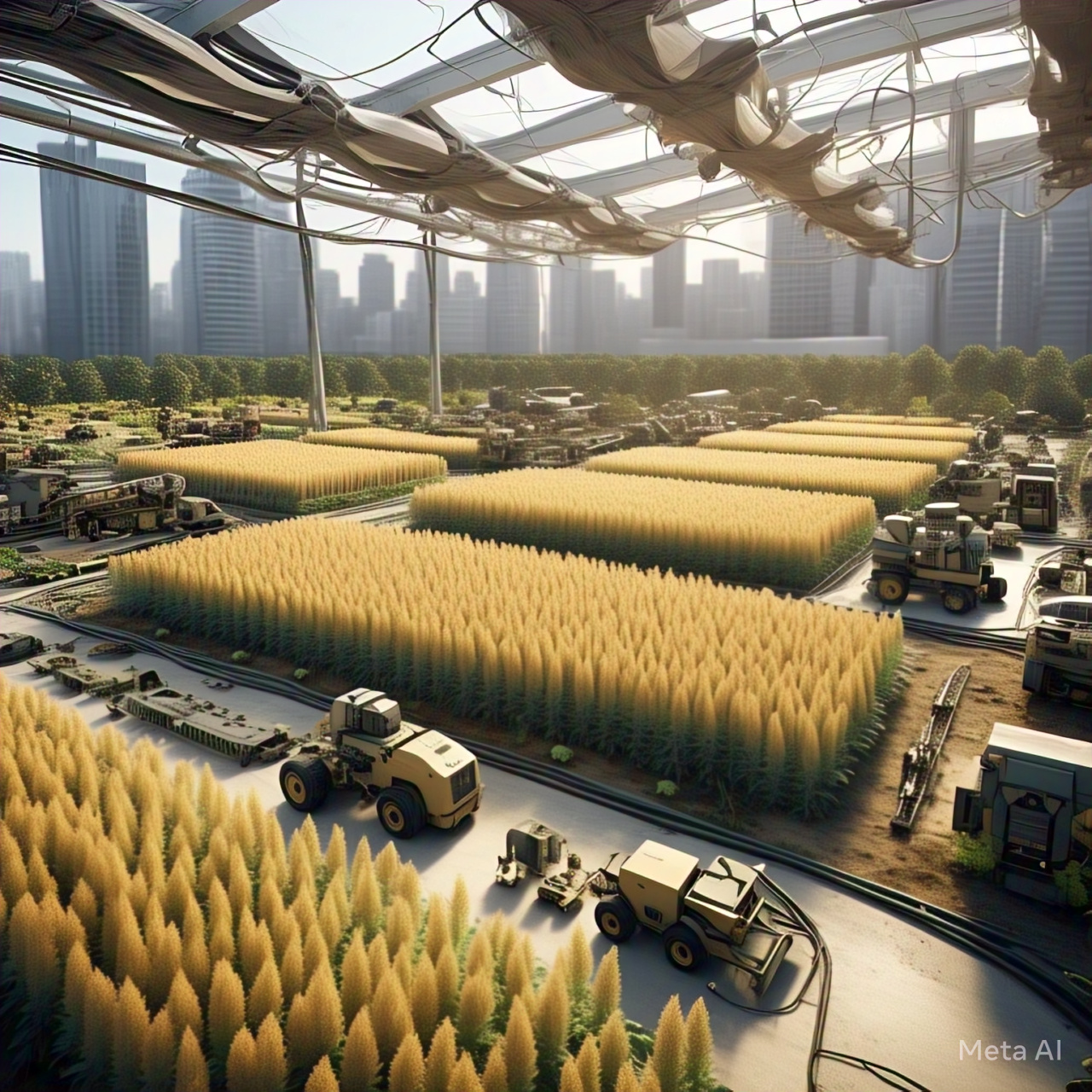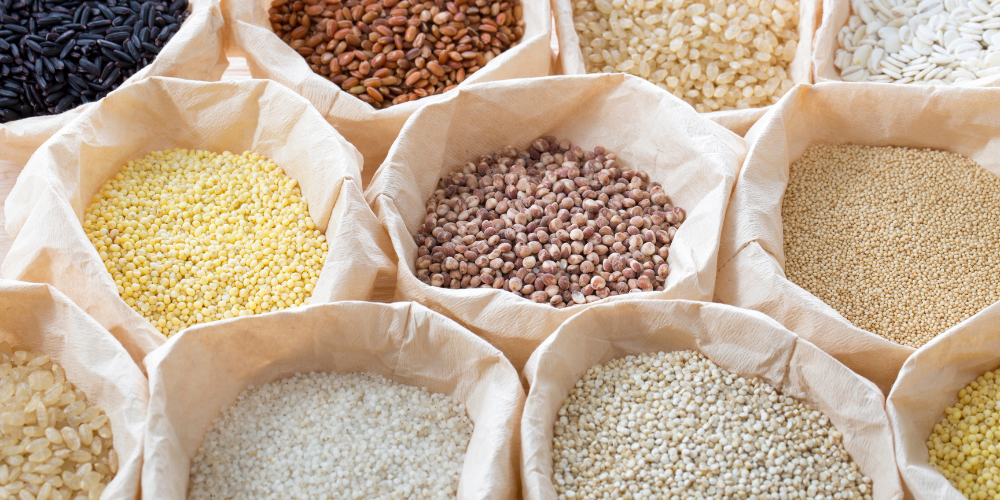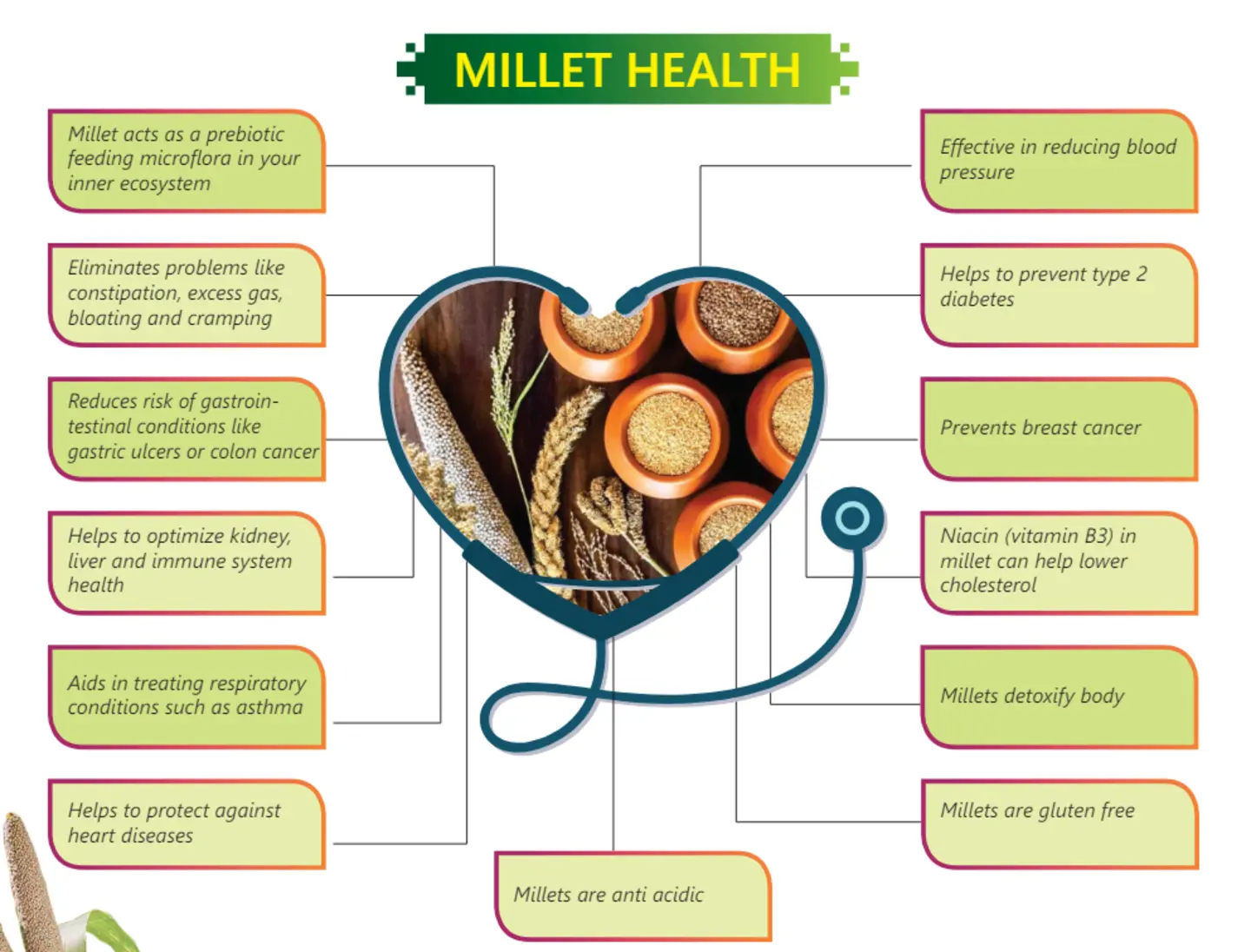Are Millets Sustainable? – The Future of Sustainable Farming
Are Millets Sustainable?–Discover how millets contribute to sustainability, require less water, and support eco-friendly farming.
Are Millets Sustainable? Millets are a highly sustainable crop, requiring significantly less water than traditional grains like rice and wheat. Their natural resilience allows them to thrive in dry and arid conditions with minimal chemical inputs, making them an eco-friendly choice for farming. Are Millets Sustainable? Yes! Millets support biodiversity, enhance soil fertility, and contribute to food security by providing essential nutrients. Their ability to withstand extreme weather conditions makes them a reliable crop amidst climate change challenges. As global agriculture shifts towards sustainability, Are Millets Sustainable? Absolutely! Millets play a crucial role in reducing environmental impact and promoting long-term ecological balance.
Are Millets Sustainable? – Introduction

Millets are gaining global recognition as a sustainable and eco-friendly crop. With their ability to grow in dry, arid regions with minimal water and chemical inputs, millets stand out as a solution to climate change and food security challenges. But are millets sustainable? Let’s explore how millets contribute to sustainable farming and why they are becoming a preferred choice for farmers worldwide.
Are millets sustainable? This question is gaining global attention as the world seeks sustainable agricultural solutions. Millets are known for their ability to grow in arid regions with minimal water and chemical inputs, making them a resilient crop in the face of climate change. Their adaptability and low environmental impact have positioned them as a key player in sustainable farming initiatives worldwide.
Are millets sustainable? One of the key factors that make millets a sustainable crop is their minimal resource requirements. Unlike traditional staple crops like rice and wheat, millets require significantly less water and can thrive in nutrient-poor soils without excessive chemical fertilizers. This not only reduces farming costs but also helps conserve vital natural resources, ensuring long-term agricultural sustainability.
Are millets sustainable? As consumer demand for eco-friendly and nutritious food grows, millets are emerging as a preferred choice for farmers and policymakers alike. Their high nutritional value, climate resilience, and ability to enhance soil health make them an integral part of sustainable food production systems. By integrating millets into modern agricultural practices, we can promote food security while reducing the environmental impact of farming.
Are Millets Sustainable? – Key Factors of Sustainability
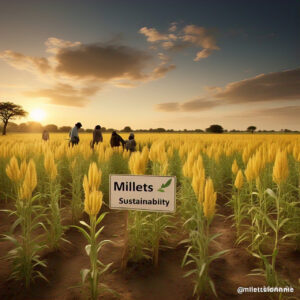
Are millets sustainable? Millets are widely recognized for their sustainability due to their ability to grow in harsh climates with minimal resources. Unlike traditional staple crops such as rice and wheat, millets require significantly less water, making them an excellent choice for regions facing water scarcity. Additionally, their natural resistance to pests and diseases reduces the need for chemical pesticides and fertilizers, promoting healthier soil and reducing environmental pollution.
This makes millet farming not only eco-friendly but also a viable option for improving agricultural sustainability. Are millets sustainable? Their ability to thrive in challenging environments while requiring fewer resources makes them an ideal solution for sustainable agriculture. Unlike traditional staple crops such as rice and wheat, millets require significantly less water, making them an excellent choice for regions facing water scarcity. Additionally, their natural resistance to pests and diseases reduces the need for chemical pesticides and fertilizers, promoting healthier soil and reducing environmental pollution. This makes millet farming not only eco-friendly but also a viable option for improving agricultural sustainability.
Are millets sustainable? Another crucial factor contributing to the sustainability of millets is their role in climate resilience and food security. Millets can withstand extreme weather conditions, including droughts and high temperatures, which makes them a reliable crop amidst the challenges of climate change. Their deep root systems help in preventing soil erosion and enhancing soil fertility. Furthermore, their high nutritional value provides a healthy and sustainable food source, making them an essential component of global food security initiatives. Are millets sustainable? Their ability to support biodiversity, maintain soil health, and provide essential nutrients highlights their importance in sustainable farming.
Millets can withstand extreme weather conditions, including droughts and high temperatures, which makes them a reliable crop amidst the challenges of climate change. Their deep root systems help in preventing soil erosion and enhancing soil fertility. Furthermore, their high nutritional value provides a healthy and sustainable food source, making them an essential component of global food security initiatives. Millets have several characteristics that make them an ideal choice for sustainable agriculture.
1. Are Millets Sustainable in Terms of Water Usage?
Unlike rice and wheat, which require extensive irrigation, millets thrive in rainfed conditions, reducing the strain on water resources. This makes them an excellent crop for drought-prone regions.
2. Are Millets Sustainable for Soil Health?
Millets are naturally resistant to pests and diseases, requiring fewer pesticides and synthetic fertilizers. This leads to healthier soil and less chemical pollution in the environment.
3. Are Millets Sustainable in Climate Resilience?
Millets can withstand extreme weather conditions, including high temperatures and poor soil quality. Their deep root systems prevent soil erosion and improve soil health over time.
4. Are Millets Sustainable for Nutrition?
Apart from being eco-friendly, millets are rich in essential nutrients such as fiber, protein, and antioxidants. They offer a sustainable food solution that meets the nutritional needs of growing populations.

Are millets sustainable? Millets play a crucial role in promoting eco-friendly farming by enhancing soil fertility and reducing the reliance on synthetic fertilizers. Their ability to grow in poor soil conditions helps farmers maintain soil health without excessive use of chemicals. Additionally, millets contribute to crop rotation practices, allowing the soil to recover its nutrients and reducing the risk of soil depletion. Their short growing cycle ensures that multiple crops can be cultivated within a single season, further improving land utilization and sustainability.
Are millets sustainable? Their natural ability to enhance soil health while requiring fewer resources makes them a key crop for sustainable agriculture. Their ability to grow in poor soil conditions helps farmers maintain soil health without excessive use of chemicals. Additionally, millets contribute to crop rotation practices, allowing the soil to recover its nutrients and reducing the risk of soil depletion. Their short growing cycle ensures that multiple crops can be cultivated within a single season, further improving land utilization and sustainability.
Are millets sustainable? Another way millets support eco-friendly farming is by significantly lowering greenhouse gas emissions. Compared to rice and wheat, millet farming produces fewer methane emissions, making them a better choice for reducing agriculture’s environmental impact. Moreover, millet cultivation supports biodiversity by fostering a more diverse agricultural ecosystem. By encouraging a variety of plant species and attracting beneficial insects, millet farms help maintain ecological balance and reduce the negative effects of monoculture farming. Are millets sustainable? Their contribution to lowering emissions and supporting biodiversity makes them an essential part of an eco-friendly farming future.
Compared to rice and wheat, millet farming produces fewer methane emissions, making them a better choice for reducing agriculture’s environmental impact. Moreover, millet cultivation supports biodiversity by fostering a more diverse agricultural ecosystem. By encouraging a variety of plant species and attracting beneficial insects, millet farms help maintain ecological balance and reduce the negative effects of monoculture farming.
1. Are Millets Sustainable for Enhancing Soil Fertility?
Millets enrich the soil with organic matter, improving its fertility. Their short growing cycle also allows farmers to practice crop rotation, further enhancing soil health.
2. Are Millets Sustainable for Reducing Greenhouse Gas Emissions?
Compared to rice and wheat, millet farming emits significantly lower greenhouse gases. This makes them an essential crop for reducing agriculture’s carbon footprint.
3. Are Millets Sustainable for Biodiversity?
Millets support diverse ecosystems by providing a habitat for beneficial insects and reducing the need for monoculture farming, which depletes soil nutrients.
Are Millets Sustainable? – Their Role in Agriculture

Are millets sustainable? Millets play a significant role in sustainable agriculture by offering a climate-resilient alternative to traditional crops. Their ability to grow in arid and semi-arid regions with minimal water makes them a crucial choice for farmers facing water scarcity. Unlike rice and wheat, which depend on extensive irrigation, millets thrive under rainfed conditions, reducing the strain on freshwater resources. This characteristic not only benefits the environment but also ensures long-term agricultural sustainability in regions prone to droughts and erratic weather patterns. Are millets sustainable? Their adaptability to challenging climates and ability to conserve water make them an essential part of sustainable farming.
Their ability to grow in arid and semi-arid regions with minimal water makes them a crucial choice for farmers facing water scarcity. Unlike rice and wheat, which depend on extensive irrigation, millets thrive under rainfed conditions, reducing the strain on freshwater resources. This characteristic not only benefits the environment but also ensures long-term agricultural sustainability in regions prone to droughts and erratic weather patterns.
Are millets sustainable? In addition to their low input requirements, millets contribute to improving farmers’ livelihoods by reducing cultivation costs. Since they require fewer pesticides and fertilizers, farmers can achieve higher profit margins while maintaining healthier soils. Governments and agricultural organizations are increasingly recognizing this advantage and supporting millet farming through subsidies and promotional campaigns, further encouraging farmers to adopt these resilient crops. Are millets sustainable? Their economic benefits and support from global initiatives highlight their role in sustainable agriculture. Since they require fewer pesticides and fertilizers, farmers can achieve higher profit margins while maintaining healthier soils.
Governments and agricultural organizations are increasingly recognizing this advantage and supporting millet farming through subsidies and promotional campaigns, further encouraging farmers to adopt these resilient crops.
Are millets sustainable? Furthermore, millets play a vital role in global food security. As the world grapples with climate change and population growth, the demand for nutrient-dense, sustainable food sources is rising. Millets offer a reliable alternative due to their rich nutritional profile, including high fiber, protein, and essential minerals.
By integrating millets into mainstream agriculture, countries can enhance food availability, support rural economies, and promote sustainable farming practices on a larger scale. Are millets sustainable? Their ability to provide essential nutrition while supporting ecological balance makes them a key factor in food security strategies. As the world grapples with climate change and population growth, the demand for nutrient-dense, sustainable food sources is rising. Millets offer a reliable alternative due to their rich nutritional profile, including high fiber, protein, and essential minerals. By integrating millets into mainstream agriculture, countries can enhance food availability, support rural economies, and promote sustainable farming practices on a larger scale.
1. Are Millets Sustainable for Water Conservation?
The low water requirement of millets makes them an ideal choice for regions facing water scarcity. Unlike rice cultivation, which consumes vast amounts of freshwater, millets grow efficiently in semi-arid conditions.
2. Are Millets Sustainable for Farmers’ Livelihoods?
Since millets require fewer inputs and have lower production costs, they offer higher profit margins to farmers. Governments and organizations are increasingly supporting millet farming through subsidies and incentives.
3. Are Millets Sustainable for Food Security?
As the world faces climate change challenges, millets provide a reliable food source due to their resilience and nutritional value. This makes them a crucial part of global food security strategies.
Are Millets Sustainable? – Future of Millets in Global Agriculture
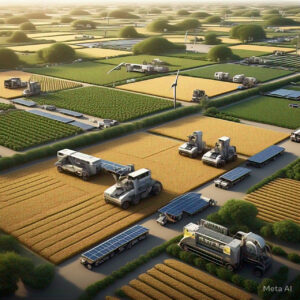
Are millets sustainable? The future of global agriculture increasingly points toward the adoption of millets as a key solution to climate change, soil degradation, and water scarcity. With their ability to thrive in harsh environments with minimal resources, millets are becoming a staple crop in sustainable farming initiatives. Governments and agricultural organizations worldwide are promoting millet cultivation through policies, subsidies, and awareness campaigns, ensuring a shift toward more eco-friendly agricultural practices. As consumer demand for sustainable and nutritious food grows, millets are positioned to play a crucial role in shaping the future of food production.
In addition to their environmental benefits, millets contHow to Start a Millet Export BusinessHow Millets help in Weight Loss A Complete GuideMillets in Hindi: A Comprehensive Guide to the Nutritious Superfoodribute to economic sustainability by offering farmers a resilient and profitable crop. Their low input requirements and adaptability to diverse climates make them a viable option for small and large-scale farmers alike. Furthermore, as global food security concerns rise, millets provide a reliable alternative to traditional grains, ensuring a steady food supply even in the face of extreme weather conditions.
The integration of millets into mainstream agriculture will be a game-changer, promoting sustainability, improving rural livelihoods, and supporting a more resilient global food system. With increasing concerns about climate change, food security, and water scarcity, millets are poised to play a significant role in future agricultural practices. Governments and organizations worldwide are promoting millet cultivation through incentives and awareness programs.
Frequently Asked Questions (FAQs)
1. Are millets better than rice and wheat for sustainability?
Yes, millets require less water, use fewer chemicals, and are more resilient to climate change compared to rice and wheat.
2. How do millets help in reducing water consumption?
Millets grow well in rainfed conditions and require significantly less irrigation than water-intensive crops like rice.
3. Can millets improve soil health?
Yes, millets improve soil fertility by preventing erosion and enhancing organic matter content.
4. Is millet farming profitable for farmers?
With increasing demand for healthy and sustainable food options, millet farming is becoming a profitable alternative for farmers.
5. What are some of the most popular types of millets?
Some popular types of millets include pearl millet, foxtail millet, finger millet, and sorghum.
Are Millets Sustainable? – Final Thoughts
Millets are a game-changer in sustainable farming, offering numerous environmental and economic benefits. Their ability to thrive in challenging conditions, conserve water, and enhance soil health makes them the future of eco-friendly agriculture. As the world moves toward more sustainable food sources, embracing millet cultivation will be key to ensuring food security and environmental conservation.
Are millets sustainable? As the world continues to grapple with environmental challenges and food security concerns, millets are proving to be an essential part of the solution. Their ability to thrive in harsh conditions while requiring fewer resources makes them a valuable asset in the quest for sustainable agriculture. By promoting millet cultivation, farmers can reduce their dependence on water-intensive crops, leading to long-term ecological balance.
Are millets sustainable? The economic benefits of millet farming further add to their appeal. Farmers experience lower input costs, improved soil health, and increased resilience against climate-related adversities. Additionally, government initiatives and international organizations are supporting millet production, recognizing their potential to address both nutritional and environmental challenges.
Are millets sustainable? Their role in mitigating climate change cannot be overlooked. By reducing greenhouse gas emissions, preserving biodiversity, and enhancing soil fertility, millets help create a more sustainable food system. As awareness grows, consumers and businesses are increasingly incorporating millets into their diets and supply chains, further driving demand.
Are millets sustainable? The future of global agriculture depends on crops that are resilient, nutritious, and environmentally friendly. Millets meet all these criteria, making them an ideal choice for modern farming practices. Encouraging their widespread adoption can help countries achieve food security while safeguarding natural resources.
Are millets sustainable? With their numerous benefits, millets are more than just an alternative crop; they are a necessity for the future of agriculture. By investing in millet production, we can create a more sustainable, resilient, and food-secure world for generations to come.

